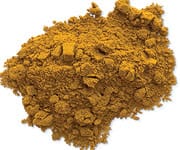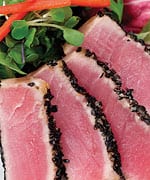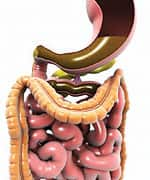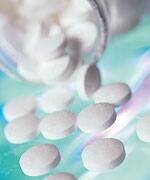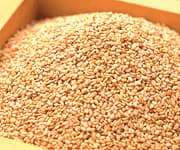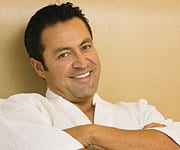Life Extension Magazine®
High Vegetable Consumption Slows Cognitive Decline | |
Eating vegetables may help slow age-related decline in cognitive function, according to a recent study funded by the National Institute on Aging.13 Researchers evaluated food-frequency questionnaires completed by 3,718 Chicago residents aged 65 and older. Participants completed at least two of three cognitive function tests conducted at the study’s onset and at three and six years. Vegetable consumption was associated with a reduced rate of cognitive decline. Green leafy vegetables were found to have the strongest association, and older people appeared to benefit the most. “Compared to people who consumed less than one serving of vegetables a day, people who ate at least 2.8 servings of vegetables a day saw their rate of cognitive change slow by roughly 40%,” the researchers concluded. “This decrease is equivalent to about five years of younger age.” —Dayna Dye | |
Aspirin Combats Cancer by Inhibiting Angiogenesis | |
Aspirin, which is already recognized as being protective against some cancers due to its ability to inhibit the cyclooxygenase (COX) enzyme, may also fight tumors by directly reducing angiogenesis, or new blood vessel growth.14 Researchers in England compared the effects of varying concentrations of aspirin, salicylate (the natural form of aspirin), and the selective COX inhibitors SC560 and celecoxib (Celebrex®) on the proliferation, viability, and angiogenesis of cultured endothelial cells. While therapeutic concentrations of aspirin and salicylate had no effect on cell viability or proliferation, angiogenesis was significantly reduced. This effect was seen even at the lowest concentrations of aspirin and salicylate used, but was not observed with the COX inhibitor drugs. —Dayna Dye | |
Green Tea Flavonal May Improve Glucose Control | |
Swiss researchers report that epigallocatechin gallate (EGCG), a flavonal in green tea, alleviates diabetes in mice and rats.15 Type II diabetic mice were given diets containing 2.5, 5, or 10 grams per kilogram of a green tea extract providing over 94% EGCG. A control group of diabetic mice received no EGCG, and another group was treated with an anti-diabetic drug. EGCG dose-dependently improved glucose levels and tolerance in diabetic mice after five weeks. Mice that received the highest dose experienced a 37% average reduction in glucose levels compared to animals that did not receive the compound. Triglyceride levels were also dose-dependently reduced and insulin secretion was increased. “Dietary supplementation with EGCG could potentially contribute to nutritional strategies for the prevention and treatment of type II diabetes mellitus,” the authors concluded. —Dayna Dye | |
Compound in Sesame Lignans Enhances Endothelial Function | |
Sesamol, an antioxidant compound derived from sesame seed lignans, may promote cardiovascular health by influencing the production of nitric oxide, Taiwanese scientists recently reported.16 By relaxing blood vessel walls and promoting blood flow, nitric oxide fights the development of atherosclerosis, which is characterized by a thickening and loss of elasticity in the arteries, followed by the development of blood-flow-reducing arterial plaques. Nitric oxide also inhibits platelet aggregation, further reducing the likelihood of plaque formation and the incidence of dangerous blood-borne clots implicated in stroke. Using endothelial cells from umbilical cord veins, the Taiwanese scientists showed that sesamol “switches on” genes that direct the production of nitric oxide synthase, an enzyme that in turn orchestrates the production of nitric oxide. —Dale Kiefer | |
Study Advises Prostate Screening Starting at Age 40 | |
Johns Hopkins researchers recently recommended screening for prostate cancer in men beginning at age 40. In addition, say the scientists, prostate cancer diagnosis should be based on multiple readings over time that would show how a man’s prostate-specific antigen (PSA) level changes, not on a single reading.17 These changes would reduce the number of men treated unnecessarily and would better identify potentially deadly tumors that require aggressive treatment, according to the researchers. The team tracked nearly 1,000 men in the Baltimore area who volunteered for a long-term study of aging that began in 1958. Using frozen blood samples, the researchers explored whether the speed at which a man’s PSA levels changed was a good predictor of his chances of dying of prostate cancer. They found that the faster a man’s PSA level increased, the more likely he was to die of prostate cancer. Dr. H. Ballentine Carter, professor of urology and oncology at the Johns Hopkins University School of Medicine and the study’s lead author, said, “We don’t need to diagnose more prostate cancer. We need to find the prostate cancers that are fatal.” —Matt Sizing | |
Ginger Holds Promise for Diabetes Treatment | |
| Ginger helped to improve several manifestations of diabetes in animals with experimentally induced diabetes, according to a recent publication.18 In the laboratory, scientists treated rats with a chemical in order to induce diabetes. Accordingly, the rats displayed typical manifestations of diabetes, including high blood sugar and weight loss. Next, the scientists administered raw ginger (500 mg per kilogram of body weight per day) to the subjects for seven weeks. Diabetic rats that received ginger had markedly lower levels of blood sugar, cholesterol, and triglycerides than rats not treated with ginger. Ginger apparently improved other complications of diabetes as well, by reducing loss of protein in the urine, excess water intake, excess urine output, and weight loss. The research team concluded that raw ginger helps decrease blood sugar, cholesterol, and lipid levels in experimental test subjects. Further study is indicated to learn if ginger produces the same effects in humans with diabetes. —Laura J. Ninger, ELS | |
Scientists Grow “Mini Liver” from Stem Cells | |
British scientists have grown a coin-sized “mini liver” from stem cells, a breakthrough that could lead to the production of transplantable organs.19 They employed readily available human umbilical cord blood to produce “cord-blood-derived embryonic-like stem cells,” avoiding the highly controversial use of embryonic stem cells. The scientists coaxed the cells to differentiate into complex liver tissues by incubating them with a special mixture of enzymes and nutrients in a NASA-designed “bioreactor.” This device allows cells to grow more rapidly and facilitates growth in three dimensions, a stumbling block that has previously hindered development of complex tissues from stem cells. Although scientists have previously developed simple tissues using somewhat similar techniques, this marks the first time a complex organ has been synthesized using non-embryonic stem cells. The researchers anticipate that mini-organs will be available for transplantation within two years. —Dale Kiefer | |
European Doctors Advise Fish Oil After Heart Attacks | |
| Although heart-attack survivors in Europe are routinely prescribed fish oil, this practice is rarely followed in the United States, according to a recent report in the New York Times.20 In numerous studies, fish oil rich in omega-3 fatty acids has been shown to improve survival after heart attacks and to reduce fatal heart rhythms. In the US, however, heart attack victims are rarely given omega-3 fatty acids, though they are routinely prescribed more expensive and invasive treatments, such as cholesterol-lowering drugs and implantable defibrillators. Dr. Terry Jacobson, a preventive cardiologist at Emory University in Atlanta, told the Times, “Most cardiologists here are not giving omega-3s, even though the data support it—there’s a real disconnect. They have been very slow to incorporate the therapy.” Wide variations in cardiac care around the world underscore the decisive role that drug companies play in disseminating medical information, according to the Times report. Because prescription fish oil is not licensed to prevent heart disease in the US, drug companies may not legally promote it for that purpose, and doctors routinely fail to recommend it to their patients. According to a recent study published in the Journal of the American Board of Family Medicine, only 17% of family doctors were likely to prescribe fish oil to their patients, including those who had suffered a heart attack. The authors concluded that there was a great need to “improve awareness of this important advice.” In a landmark study of fish oil conducted more than a decade ago, Italian researchers from the GISSI Group gave 11,000 patients 1 gram of prescription fish oil a day after they had suffered a heart attack. After three years, the number of deaths was reduced by 20% and the number of sudden deaths by 40% compared to a control group. By 2004, medical regulatory authorities in almost all European countries, including Spain, France and Britain, had approved prescription fish oil for use in heart attack patients. The American College of Cardiology now advises patients with coronary artery disease to increase their consumption of omega-3 acids to 1 gram a day. Dr. Maria Franzosi, a researcher at the Mario Negri Institute in Milan, told the Times that the use of fish oil “is very popular here in Italy, I think partly because so many cardiologists in this country participated in the studies and were aware of the results. In other countries, uptake may be harder because doctors think of it as just a dietary intervention.” Research on fish oil continues to gain momentum in Europe. Researchers from the GISSI Group are now conducting two major trials to examine fish oil’s effects in patients with abnormal heart rhythms and in patients with heart failure. —Matt Sizing | |
| References | |
| 1. Ng TP, Chiam PC, Lee T, Chua HC, Lim L, Kua EH. Curry consumption and cognitive function in the elderly. Am J Epidemiol. 2006 Nov 1;164(9):898-906. 2. Orwoll E, Lambert LC, Marshall LM, et al. Endogenous testosterone levels, physical performance, and fall risk in older men. Arch Intern Med. 2006 Oct 23;166(19):2124-31. 3. Buenz EJ, Rodriguez M, Howe CL. Disrupted spatial memory is a consequence of picornavirus infection. Neurobiol Dis. 2006 Nov;24(2):266-73. 4. Juan ME, Wenzel U, Ruiz-Gutierrez V, Daniel H, Planas JM. Olive fruit extracts inhibit proliferation and induce apoptosis in HT-29 human colon cancer cells. J Nutr. 2006 Oct;136(10):2553-7. 5. Lagiou P, Trichopoulos D, Sandin S, et al. Mediterranean dietary pattern and mortality among young women: a cohort study in Sweden. Br J Nutr. 2006 Aug;96(2):384-92. 6. Estruch R, Martinez-Gonzalez MA, Corella D, et al. Effects of a Mediterranean-style diet on cardiovascular risk factors: a randomized trial. Ann Intern Med. 2006 Jul 4;145(1):1-11. 7. Rodriguez MC, Macdonald JR, Mahoney DJ, Parise G, Beal MF, Tarnopolsky MA. Beneficial effects of creatine, CoQ(10), and lipoic acid in mitochondrial disorders. Muscle Nerve. 2006 Nov 1; [Epub ahead of print] 8. Ziegler D, Ametov A, Barinov A, et al. Oral treatment with alpha-lipoic acid improves symptomatic diabetic polyneuropathy: the SYDNEY 2 trial. Diabetes Care. 2006 Nov;29(11):2365-70. 9. Kim HK, Della-Ferra M, Lin J, Baile CA. Docosahexaenoic acid inhibits adipocyte differentiation and induces apoptosis in 3T3-L1 preadipocytes. J Nutr. 2006 Dec (12);136:2965-9. 10. Ruzickova J, Rossmeisl M, Prazak T, Flachs P. Omega-3 PUFA of marine origin limit diet-induced obesity in mice by reducing cellularity of adipose tissue. Lipids. 2004 Dec;39(12):1177-85. 11. Wang H, Storlien LH, Huang XF. Effects of dietary fat types on body fatness, leptin, and ARC leptin receptor, NPY, and AgRP mRNA expression. Am J Physiol Endocrinol Metab. 2002 Jun;282(6):E1352-9. 12. Knock E, Deng L, Wu Q, Leclerc D, Wang XL, Rozen R. Low dietary folate initiates intestinal tumors in mice, with altered expression of g2-m checkpoint regulators polo-like kinase 1 and cell division cycle 25c. Cancer Res. 2006 Nov 1;66(21):10349-56. 13. Morris MC, Evans DA, Tangney CC, Bienias JL, Wilson RS. Associations of vegetable and fruit consumption with age-related cognitive change. Neurology. 2006 Oct 24;67(8):1370-6. 14. Borthwick GM, Johnson AS, Partington M, Burn J, Wilson R, Arthur HM. Therapeutic levels of aspirin and salicylate directly inhibit a model of angiogenesis through a Cox-independent mechanism. FASEB J. 2006 Oct;20(12):2009-16. 15. Wolfram S, Raederstorff D, Preller M, Wang Y, Teixeira SR, Riegger C, Weber P. Epigallocatechin gallate supplementation alleviates diabetes in rodents. J Nutr. 2006 Oct;136(10):2512-8. 16. Chen PR, Tsai CE, et al. Sesamol induces nitric oxide release from human umbilical vein endothelial cells. Lipids. 2005 Sep;40(9):955-61. 17. Carter HB, Ferrucci L, Kettermann A, et al. Detection of life-threatening prostate cancer with prostate-specific antigen velocity during a window of curability. J Natl Cancer Inst. 2006 Nov 1;98(21):1521-7. 18. Al-Amin ZM, Thomson M, Al-Qattan KK, Peltonen-Shalaby R, Ali M. Anti-diabetic and hypolipidaemic properties of ginger (Zingiber officinale) in streptozotocin-induced diabetic rats. Br J Nutr. 2006 Oct;96(4):660-6. 19. McGuckin CP, Forraz N, et al. Production of stem cells with embryonic characteristics from human umbilical cord blood. Cell Prolif. 2005 Aug;38(4):245-55. 20. Rosenthal E. In Europe it’s fish oil after heart attacks, but not in US. New York Times. October 3, 2006. |

